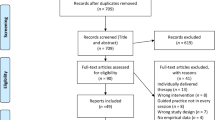Abstract
Mindfulness groups have become widespread and the evidence for efficacy in inpatient settings is developing. The current paper looks at the development and application of a mindfulness group for both staff and service users on an inpatient unit. Seventeen participants (7 staff, 10 clients) attended a 9 week mindfulness group based on a long stay inpatient unit. The group was demonstrated to be positively received and increased participant’s confidence in applying mindfulness skills. Challenges with attendance and the ward environment were highlighted. Mixed groups of this nature appear to be feasible and well received in these contexts. Experiences of the group and the future directions are discussed.

Similar content being viewed by others
References
Kabat-Zinn J. Mindfulness-based interventions in context: past, present, and future. Clin Psychol Sci Pract. 2003;10(2):144–56.
Martin JR. Mindfulness: a proposed common factor. J Psychother Integr. 1997;7(4):291.
Bishop SR, Lau M, Shapiro S, Carlson L, Anderson ND, Carmody J, Segal ZV, Abbey S, Speca M, Velting D, Devins G. Mindfulness: a proposed operational definition. Clin Psychol Sci Pract. 2004;11(3):230–41.
Fjorback LO, Arendt M, Ørnbøl E, Fink P, Walach H. Mindfulness based stress reduction and mindfulness based cognitive therapy—a systematic review of randomized controlled trials. Acta Psychiatr Scand. 2011;124(2):102–19.
Grossman P, Niemann L, Schmidt S, Walach H. Mindfulness-based stress reduction and health benefits: a meta-analysis. J Psychosom Res. 2004;57(1):35–43.
Mollon P. The NICE guidelines are misleading, unscientific, and potentially impede good psychological care and help. Psychodyn Pract. 2009;15(1):9–24.
Jacobsen P, Morris E, Johns L, Hodkinson K. Mindfulness groups for psychosis; key issues for implementation on an inpatient unit. Behav Cognit Psychother. 2011;39(03):349–53.
Chadwick P, Taylor KN, Abba N. Mindfulness groups for people with psychosis. Behav Cognit Psychother. 2005;33(03):351–9.
Chadwick P, Hughes S, Russell D, Russell I, Dagnan D. Mindfulness groups for distressing voices and paranoia: a replication and randomized feasibility trial. Behav Cognit Psychother. 2009;37(04):403–12.
Langer ÁI, Cangas AJ, Salcedo E, Fuentes B. Applying mindfulness therapy in a group of psychotic individuals: a controlled study. Behav Cognit Psychother. 2012;40(01):105–9.
Segal ZV, Williams JM, Teasdale JD. Mindfulness-based cognitive therapy for depression. New York: Guilford Press; 2012.
Linehan M. Cognitive-behavioral treatment of borderline personality disorder. New York: Guilford Press; 1993.
Yorston GA. Mania precipitated by meditation: a case report and literature review. Ment Health Relig Cult. 2001;4(02):209–13.
Khoury B, Lecomte T, Gaudiano BA, Paquin K. Mindfulness interventions for psychosis: a meta-analysis. Schizophr Res. 2013;150(1):176–84.
Didonna F (ed). Mindfulness-based interventions in an inpatient setting. In: Clinical handbook of mindfulness. Springer: New York; 2009. p. 447–62.
Hofmann SG, Sawyer AT, Witt AA, Oh D. The effect of mindfulness-based therapy on anxiety and depression: a meta-analytic review. J Consult Clin Psychol. 2010;78(2):169.
Moorhead S. Report of a feasibility study of a Mindfulness group for clients, carers and staff of an early intervention in psychosis service. Cognit Behav Ther. 2012;5(04):93–101.
Baer RA, Smith GT, Hopkins J, Krietemeyer J, Toney L. Using self-report assessment methods to explore facets of mindfulness. Assessment. 2006;13(1):27–45.
Christopher MS, Neuser NJ, Michael PG, Baitmangalkar A. Exploring the psychometric properties of the five facet mindfulness questionnaire. Mindfulness. 2012;3(2):124–31.
Author information
Authors and Affiliations
Corresponding author
Ethics declarations
Conflict of interest
The authors declare that they have no conflict of interest.
Appendices
Appendix 1
Session Topics
Each session was based around an experiential mindfulness exercise. These exercises were drawn from a number of sources including Chadwick, Kabat-Zinn, Teasdale, Williams and others. Participants would then spend time discussing and reflecting on this. Sessions lasted approximately 40 min to 1 h.
-
1.
What is mindfulness and how can it be helpful?
-
2.
Living in the past and the future: the problem of worrying about worry
-
3.
Switching off autopilot
-
4.
Mindfulness grounded in the body
-
5.
Letting go of our reactions
-
6.
Mindfulness in everyday life
-
7.
Turning towards difficult experiences
-
8.
Noticing our thoughts as thoughts—not facts
-
9.
Working towards acceptance
Appendix 2
Questions Asked in Focus Group Interviews
What were your reasons for attending the group?
Has your understanding of what mindfulness is changed since starting the group?
Did you have the opportunity to practice mindfulness during the group?
Have you practiced mindfulness outside of the group?
Will you take anything away from the group?
In what ways was the group useful?
In what ways was it less useful?
What could we do differently?
Any other comments or reflections on the group?
Appendix 3
Rights and permissions
About this article
Cite this article
Oddi, M., Bennett, R. Mixed Staff and Client Mindfulness Groups in a Long Stay Inpatient Setting: An Evaluation. J. Psychosoc. Rehabil. Ment. Health 3, 95–100 (2016). https://doi.org/10.1007/s40737-016-0063-8
Received:
Accepted:
Published:
Issue Date:
DOI: https://doi.org/10.1007/s40737-016-0063-8




